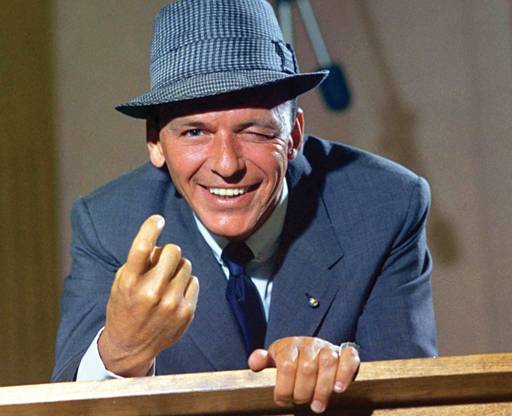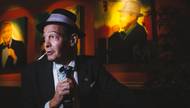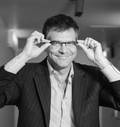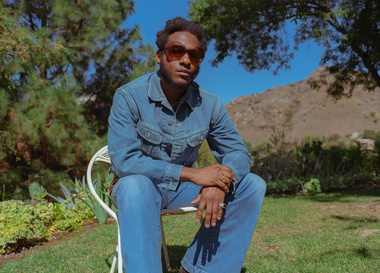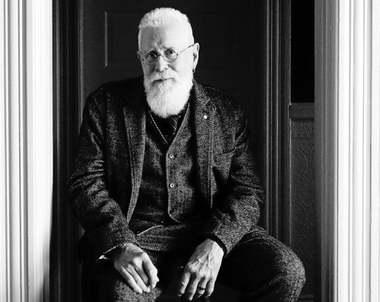Bob Anderson has been singing and performing this role all night, an adaptation that’s been a lifetime in the making. Over the previous two hours, the summer wind has blown in, luck has been a lady tonight, and the lady has been a tramp.
Anderson sets his feet for the big finale, as someone shouts a song title. “You want ‘My Way?’” he says, squinting to find that voice in the crowd. “Okay, we’ll do it.”
The great tribute artist then removes his tie, a certain indication that this spot-on interpretation of the man and his music is over. Frank Sinatra did not remove his tie onstage. Then Anderson, heeding the advice of his friend and mentor Tony Bennett, sings that last song as himself.
“There will never be another Frank Sinatra,” he says. “My name is Bob Anderson.” The crowd’s response is a thunder of applause. The close of this performance, and this run of shows called Frank: The Man, the Music, is so bittersweet. The show helmed by Anderson, in full stage makeup and a vintage-era tuxedo, is coming to a halt at Palazzo Theater after spending almost a year on the Strip. This dimming of the lights ordered by the Venetian/Palazzo hierarchy comes just two weeks short of what would have been Sinatra’s 100th birthday, December 12—a perplexing decision (at least to scores of Sinatra devotees) to stop the music without a final party honoring the Chairman of the Board.
This is the site of the Sands, after all, where Sinatra and the Rat Pack sang and cavorted in the infancy of the Strip. That hotel was long ago imploded in one of our city’s famous wipeouts of its own history. In similar fashion, Anderson’s fantastic strut down memory lane is being knocked down in favor of some entertainment advancement that requires a major overhaul of the theater that could not be put off for two weeks.
No matter. Whatever takes the place of the Sinatra show will likely be forgotten in 100 years. But not Ol’ Blue Eyes, whose indelible recordings and cocksure image defy time, and define the golden era of Vegas entertainment.
“He was the greatest singer, and he was the most popular singer, ever,” Tony Bennett says today. “People adored everything he did. He was the guy, there’s no doubt about it.”
-
Tony Bennett
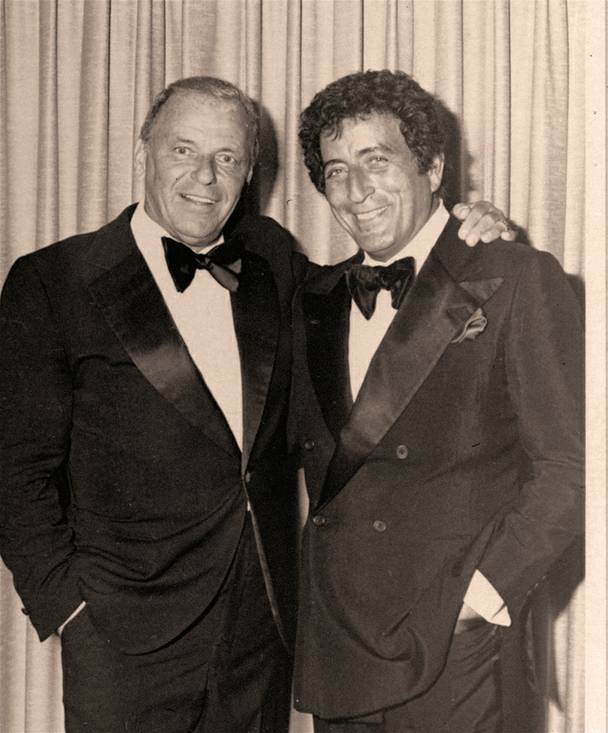
(Sinatra and Bennett in 1980 in Reno. “I loved the way he sang,” Bennett says.)
*****
Still a bankable star at age 89, Bennett is heading up a monster lineup for the CBS special Sinatra 100—An All-Star Grammy Celebration, which was recorded December 2 at Encore Theater at Wynn Las Vegas and will air December 6. The night’s array of stars includes Celine Dion, Harry Connick Jr., Lady Gaga, Garth Brooks, Trisha Yearwood, Alicia Keys, Carrie Underwood, John Legend, Adam Levine and Usher.
Bennett is the singular voice among them who was a contemporary of Sinatra. He remembers when it all started. “When I got out of the service, after World War II, Frank Sinatra was just getting big. He’d left the Tommy Dorsey Orchestra and went out on his own,” Bennett says. “He was 12 years older than I was, and I was on the jazz scene. He was already one of the biggest singers in the world at the time, a beautiful singer, and I was always kind of following him. I loved the way he sang, and I idolized him from the beginning.”
Bennett hit commercial success in his own recording career in the early ’50s, with the singles “Because of You” and “Cold, Cold Heart” hitting 1 million sales. “I was given the opportunity to be a summer replacement guest on [television’s] Perry Como Show, a very big opportunity at the time, and Sinatra was at [Times Square’s] Paramount Theatre, and I had the chance to meet him then,” Bennett says. “He had me come up to his dressing room before the show, and I was very nervous about this TV appearance. It was a very small stage; they had very few guest artists at the time.”
Sinatra took a look at the young singer and said, “What is it, kid?”
“I told him, ‘I am very nervous about this audience,’” Bennett recalls. “I didn’t know what to expect, even though I’d had a couple of million-sellers. But he said, ‘The audience is your friend. They are nice enough to come and see you, they appreciate you, and you should respect that. Give them a good show, because they are with you.’
“I never forgot that advice. It really created my career.”
Bennett is one of the few entertainers still performing who can speak to the era before Sinatra was famous. “There were some very good singers before him, you know. Rudy Vallee was a good singer, but Sinatra had a way of picking the right songs and really delivering them,” Bennett says. “A song like, ‘I Get Along Without You Very Well,’ is just so intimate. It’s a great saloon song, a song you would hear in a nightclub. One of my favorites. He had so many, of course, but more than anything he was a friend until the very end.”
Late in his life, Sinatra told Bennett he was concerned that Bennett had moved back to the East Coast and that it seemed “a boring kind of existence.” But Bennett has long been an active live performer, selling out theaters and arenas for decades whether solo or, today, in tandem with Lady Gaga. As he says, Sinatra made that box-office success possible, too.
“Years ago he did the interview with one of the great magazines, Life magazine, and was asked, ‘Everyone listens to you, but who do you listen to?’ He said, ‘For my money, Tony Benedetto is the best singer in the business. He gets to me every time.’”
Bennett chuckles. “That was 50 years ago,” he says, “and it changed my whole career. People were saying, ‘If Frank said that, we need to check him out.’ To this day, I sell out all over the world. They are still checking me out, because of Frank Sinatra.”
-
Steve Wynn
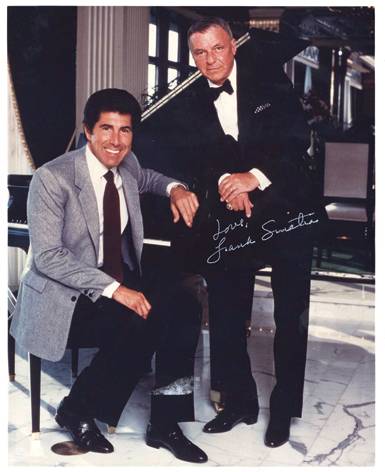
A promotional shot of Steve Wynn and Frank Sinatra taken during the singer’s run at the Golden Nugget in Atlantic City.
*****
First, the resort mogul who hired Sinatra to perform at the Golden Nugget in Atlantic City in the early 1980s explains what he wasn’t. “I wasn’t his running mate. I wasn’t his crony. I was too young—he was born the year before my parents,” Wynn says. “He wasn’t my dad, but I was the right age to be his son. I wasn’t his boss, either. I was his colleague.”
But for all of those qualifiers, Wynn reflects, “I spent a lot of time with Frank Sinatra.”
Wynn says the introduction could not have been more vintage Vegas: at the Sands’ Copa Room in December 1965, a Rat Pack performance that marked the 13th anniversary of the hotel-casino so often linked to the group. “I ended up there on a Saturday night in the 500-seat Copa Room, in an audience with Elizabeth Taylor and Gregory Peck and Lucille Ball, everyone you could imagine,” Wynn says. When [the Rat Pack] walked onstage, it was an unbelievable experience. I was so dazzled. I mean, it was the small Sands, there were 150,000 people in this town and there were at least 10,000 of those people trying to get inside that building and get a glimpse of what was going on.”
Wynn lets out a sigh, as if letting the memory marinate. “And that was it,” he says. “That’s one of the reasons I stayed here.”
Over the years, Wynn has named one of his restaurants at Encore for Sinatra, and once presented a stage show at Encore Theater, Dance With Me, which was a series of dance numbers set to Sinatra classics. But the bond between the two was cemented through Wynn’s ownership of the Golden Nugget in Atlantic City, when he booked Sinatra and Martin for a run of performances beginning in 1982. Wynn typically picked up the two superstars on his private jet in Palm Springs and flew them back to Atlantic City for the shows.
“On these flights back, Frank always did The New York Times crossword puzzle—with a pen,” Wynn recalls “Pretty good, huh?”
The two recorded a series of TV commercials, a dozen total, that aired on the East Coast (these spots are particularly remarkable for Wynn’s 1980s-coiffed hair). “Whenever I get lonely, I put on one of those commercials,” Wynn says. “I have a disc with all of them on it.”
One of his favorites is titled “Towels,” in which Wynn introduces himself to Sinatra in a hotel suite. “I’m Steve Wynn, and I run this place,” Wynn says, and Sinatra slips him a $5 bill and says, “Make sure I have enough towels.”
“Towels?!” Wynn says in a single moment picked from a dozen takes.
“I kept saying ‘towels,’ over and over, with as much pain as possible,” Wynn says, laughing. “What really made that spot was the music. We needed to get grand rights for ‘New York, New York,’ from Kander & Ebb. They didn’t just give away those rights to cut up and use a song in a commercial, because the song could very easily be bastardized.”
But Sinatra used his powers of fame and persuasion. “Frank intervened; it took him to get that done for us. We paid $75,000 a year to use ‘New York, New York,’ and it really made the commercial. If you saw it without the music, it was not nearly as funny,” Wynn says, adding that the impact was felt far beyond that one TV spot. “That’s where I learned that music in the hotel is so important in setting the mood.” So when you hear the music at Wynn/Encore, you can thank Sinatra for that, too.
Another favorite memory: Wynn and Sinatra were working across the street from one another on Park Avenue in New York City. Sinatra called and asked Wynn to lunch at Gino’s, the famous Italian restaurant (long ago closed) many blocks away on Lexington and 60th. Frank and Barbara Sinatra joined Steve and Elaine Wynn for lunch that day, and took a limo to the restaurant.
By then, Wynn had long been suffering from retinitis pigmentosa, which limited his ability to see in the dark. “We come out of the restaurant, and it’s not dark yet. The girls get in the limo, but I say to Frank, ‘I want to walk.’ It was a beautiful day, May or June, and Frank says, ‘Okay, but I’m going with you, you might walk into a lamppost,’” Wynn says. “Now, the sun is out, and I can see as well as he can, but he takes my hand and we walk from Lexington to Park, then 11 blocks down Park Avenue, with him holding my hand.” Quite a pair.
“People are walking by, doing double-takes, and I feel like I’m 12 years old,” Wynn says. “We were on television all the time, and he’s Frank Sinatra … and he looked at me and said, ‘I used to be a single.’ And you know what? I didn’t say a damn word. I loved it.”
Wynn says that he later learned Sinatra would commonly say of the casino entrepreneur, “One thing about that kid: He pays attention to everything in the joint. I love that.”
“That was his take on me,” Wynn says. “So, in other words, he watched me be as fanatical about detail as he was about his music. And that was how we came together.”
Can there be another Sinatra-styled figure who can frame the city’s image? “It can’t be done,” Wynn says. “What they did onstage was as a band of merry men, complete rascals who loved each other, no competition among them. Frank was the leader, of course. What they brought to this city were some kick-ass times, really kick-ass times.”
-
Wayne Newton
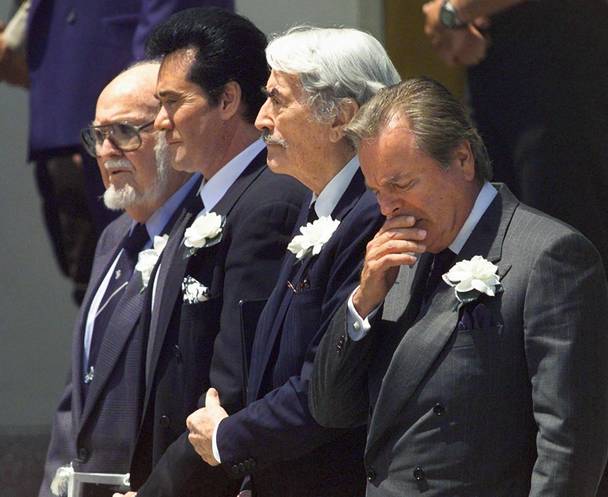
(Newton (second from left) at Sinatra's funeral in 1998, along with actors Gregory Peck (third from left) and (fourth from left) Robert Wagner).
*****
Before he became “Mr. Las Vegas,” Newton wasn’t so into Frank Sinatra. “In those days singers were generational, in that they were interested in their own era,” he says. “I was in with the Elvis craze when it hit in the late-’50s and early ’60s. When people mentioned Frank Sinatra, I knew very little about him, so I wasn’t so impressed.”
But when Newton began his career in Las Vegas in 1959, in his teens in a stage show with his brother Jerry at the Fremont Hotel, he quickly became aware of Sinatra’s influence. “When I got to Vegas, it was apparent that he was such a pivotal figure. He was huge,” Newton says. “Once I took off the blinders and was not so committed to the music of my generation, I realized what a great, great singer he was. We started doing charity shows together and developed a personal acquaintance through the early- and mid-’60s. I started really studying him and watching him to see why people were so enthralled.”
Newton rose to prominence at the Flamingo showroom in 1965. Three years later, Sinatra was headlining Caesars Palace’s then-new Circus Maximus. Newton has given a lot of thought to Sinatra over the years, and says, “Two of the things I have carried with me my entire life are things that he said.”
The first is a moment the two shared in a suite at Caesars. “He was staring out the window and turned to me and asked, ‘What do you see out there?’” Newton recalls. “I didn’t know what to say, so I said, ‘I’m not sure I understand the question. But I see the Strip, mountains, valleys.’ And he said, ‘That’s what life is—mountains and valleys. It’s that way for everybody. You’ll hit peaks and valleys, but if you do your thing, you’ll be okay.”
Years later, Newton and Sinatra were dining at Bally’s, where Sinatra was headlining in the hotel’s Celebrity Room, swapping dates with Martin, Davis and Jerry Lewis. Sinatra was approached by one of his contemporaries, a famous singer Newton declines to name on the record.
“This person comes to the table and hands Frank a copy of his new album, and says, ‘I want to know what you think of it,’” Newton says. “Frank says, ‘I can tell you before I hear it what I think of it. God gave you a great instrument in your throat, but it’s not connected to your heart.’”
Newton adds, “Talk about something that sticks with you. And Frank was not saying it to be mean. He was saying to believe what you sing, and that’s what made him special. When you think of Frank and Dean and Sammy, there was no pretext to them at all. They either liked you or they left you alone.”
Talking of these moments reminds Newton of a gift Sinatra presented him decades ago, a gold microphone on display at Newton’s Casa de Shenandoah museum.
“I was a throwback to his generation, in a lot of ways, and they all wanted to make sure that I had a place to succeed and carry on their tradition. That’s how I looked at it,” he says. “The card Frank gave me with that mic says, ‘Dear Injun, I got started on one of these when you were in a papoose.’ That’s great isn’t it? I loved it.”
-
Jerry Lewis
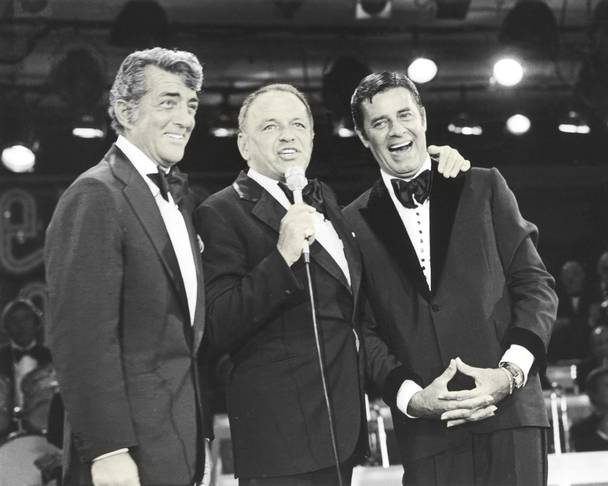
Frank Sinatra’s surprise introduction of Dean Martin at the Jerry Lewis MDA Telethon at the Sahara in September 1976.
*****
“One thing people don’t realize is that I looked a lot like Frank when I was young. Photos of us from those days are almost identical,” Lewis says. “I met him when I was very young, back in 1943. ... He came to see my show. I was appearing at the Glass Hat at the Belmont Plaza in New York, even before I worked with Dean, I’ll have ya know. And Frank walked in one night with his mother and a few people in my party.”
Sinatra had heard of Lewis, who was known to perform an impression of another rising young entertainer. “He heard I was doing an impression of him, which I did that night. I sang to a recording of his, ‘All or Nothing at All,’ and I did him very well that night,” Lewis says. “He and his mother came in a few times during the engagement. He liked the show, he liked me, and I realized then that he loved being around important people. If he had his druthers today, he would be around George Clooney.”
The two became close enough that Sinatra was apt to call Lewis and ask him to fly nearly across the country on a moment’s notice—for no specified reason. “He called me one day, this was about 1957, right in there, and I had to interrupt production of a movie I was making at the time,” Lewis says. “He said, ‘Pack up. We’re flying out. I’ll let you know when we get there.’ We wound up at an auditorium in Gary, Indiana. We walked into the hall, there’s a 30-piece orchestra onstage, and he takes me to the dressing room.”
The night was a charity show for a police officer killed on duty, who had left behind a wife and four children. Sinatra had committed himself and Lewis to perform a single benefit show for the Gary police fund.
“The place was swamped, 18,000 people in this arena, and I had no idea four hours earlier what was happening,” Lewis says. “We did a couple of hours, the place went nuts, and afterward we heard what we raised—$480,000 in one night. … This was a tremendous inspiration for the work I was doing on behalf of the [MDA] telethon, which had already started. It was a major event in my life, and Frank did this five or six times during my career.
“Hell, one night we wound up in Boston. One time we went to Hoboken. I learned to ask him, ‘Should I pack a tux? Is this a tux thing?’”
Lewis says Sinatra’s power of personality led to one of the more remarkable celebrity reunions ever, played out on the 1976 MDA Jerry Lewis Labor Day Telethon broadcast from the Sahara. During that show, Sinatra, who was onstage in conversation with Lewis, abruptly called for an old friend to join them. Of course, it was Lewis’ old comic partner, Martin.
“It was a great moment. Great. I can tell you right now, I had 400 crew members on the floor. They all knew about it. My 32-piece orchestra knew about it. My production team of 165 people knew about it,” Lewis says. “Now, wouldn’t you think somebody would slip? No. Frank made sure it was a secret. I didn’t have the faintest f*cking idea. It was so perfect, and when Frank did something like that, he had three or four of his people spread among the other people who knew about it so they would keep their mouths shut, and he did it fabulously.”
Only Sinatra could have convinced Martin to take part in such a high-risk event. This was a moment caught on live TV, fully unscripted, raw and with no guarantee of the outcome.
“We had not talked, and I mean at all, for 20 years,” Lewis says. “He is coming onto the telethon stage, where I am hosting, which is like my home court. But Frank was there to bring us together.”
Lewis says he was taken totally off-guard at the introduction of Martin by Sinatra. “If you look at the footage, look at my face, you know. I feel like I am going to pass out,” Lewis says. “I didn’t know what to say. I was never so happy to have someone take 52 steps to make it to me. I finally said, ‘So, are you working?’ And that was it. We talked nearly every day from that point on until he died. Frank brought us together.”
There’s an occasional misconception that Lewis himself was a member of the Rat Pack, or at least an extended version. He never was in that group.
“The Rat Pack came about as Dean and I were breaking up, and it was Dean’s thing. If I’d had a part of it, it would have diminished his role,” Lewis says. “I had a lot going on in those days, too, performing and doing a lot of work. My film career alone kept me very, very busy to be involved in hanging around the Rat Pack all night. My time with Frank was mostly in the day.
“So, he got Jerry in the day and Dean at night.”
As is common among even the greatest stars of Sinatra’s era, Lewis’ tone is reverential when speaking of the Chairman. “The thing that connected me and him, which he liked, was that I was open, and I think we really did inspire each other,” Lewis says. “He was always looking for ways to keep an audience’s attention, to be free onstage. He was a master at holding an audience’s attention.”
Lewis recalls one of Sinatra’s performances at the Copa Room at the Sands. “It was the opening night of his last engagement there, and he walked onstage, my God, the place was electrified,” Lewis recalls. “I was sitting in that audience, with all these people, and here was a person I knew—we had dinner together after the show—but when he was onstage, he seemed like he was someone else. It was so exciting, and I still get gooseflesh thinking about it right now.”
Lewis smiles at that statement. “That’s something, huh? I’m feeling it. But he really had that kind of effect on me.”
-
Steve Lawrence
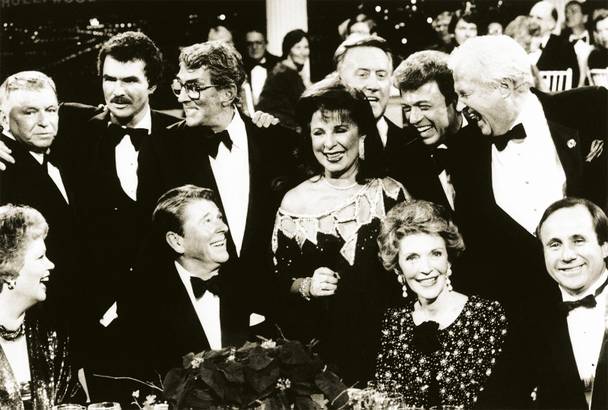
(Sinatra (far left) with an array of stars (including Lawrence, second from right) at an event for President Reagan in the 1980s.)
*****
Lawrence met Sinatra at WNEW studio in New York, the introduction made by the man Lawrence calls “the Frank Sinatra of DJs,” William B. Williams. “Willie B. was the biggest DJ in the country,” Lawrence says, “and he was the one who first called Frank the Chairman of the Board.”
A man who favored the standards for more than four decades on New York radio, Willie B. was close with Sinatra, who walked into the station randomly when a then-18-year-old Lawrence was also in the studio.
“My God, I was just in awe, standing and looking at this man,” Lawrence says. “I’m just staring at him, my eyes bugging out, and he looked at me and Willie B. says, ‘Hey, this is a new young singer, a friend of mine.’ Frank says, ‘I know, Willie plays your records a lot. You’re pretty good, kid, pretty good, and you’re going to get even better.’”
Sinatra became close with Lawrence and Eydie Gormé, the legendary husband-wife singing team Steve & Eydie. Blessed with a flawless voice himself, Lawrence recalls learning the art of phrasing from Sinatra.
“Everybody sang boop-boop-de-doop, in tempo, all the time, and they sang the words that were there on the sheet,” Lawrence says. “But they weren’t really reading it. Frank read the lyrics first, to make sure it all made sense to him; he was very conscious of that. He was a great actor, of course—he won an Oscar in From Here to Eternity—and when he approached a song he approached it in a way that was like a mini-screenplay. There was a beginning, a middle and an and. To believe a song like ‘My Way,’ you have to believe the lyric for it to work. Otherwise, you won’t reach an audience of a thousand, or 5,000, or 10,000.
“He sang in a way that everybody took it personally, individually, like he was singing directly to them.”
As many of his friends have recalled over the years, Sinatra had a great sense of humor—in the sense that he liked to laugh. “He loved jokes. He couldn’t tell ’em, but he loved ’em, and I happen to be able to tell ’em well,” Lawrence says. “Eydie and I were traveling with him for over a year on the Diamond Jubilee tour [in 1990-’91] as his opening act, through Europe, Australia, Japan. We were in Mexico, and Eydie was very big there—her Spanish-language albums sometimes outsold our English-language albums down there. And we asked him, ‘How much time do you want us to do?’”
Sinatra loosely answered, “Do whatever you want.” And Lawrence said, “Okay, tomorrow, how about you open and we close?” Sinatra halted, then laughed. “I love that. Great.”
Lawrence recalls the formative years of the Rat Pack (a name Sinatra didn’t use, favoring the Clan or the Summit or the Boys), when Sammy Davis Jr. was not permitted to stay at the Sands, where he was to perform in the Copa Room, and was directed to the short-lived Moulin Rouge.
“If you want to talk about Frank, you’ve got to know that Sammy Davis—back when he was in Vegas as part of the Will Mastin Trio—there was a big problem with him staying at the Sands because of his skin color,” Lawrence recalls. “It’s well-known that Frank broke the color code for the greatest stars, regardless of color, to be able to stay at the hotels where they worked. Frank just went to hotel management and said, ‘If you don’t let Mr. Davis stay at this hotel, I’m leaving here.’ He broke through for Sam, and subsequently for Lena Horne and Harry Belafonte, so many others, and he needs to be applauded for that.”
When asked if any other star could have made that happen, Lawrence says flatly, “No. He really was the big entertainer in Las Vegas at the time; he attracted people from all over the world, the big gamblers. Some of these guys who came to see him, if they gambled two nights, they dropped enough to pay everybody in the hotel.”
Sinatra 100
Sinatra was blessed not only with talent, but timing. “He came along when there were so many great songwriters out there: Cole Porter, Irving Berlin, Johnny Mercer, Rodgers & Hart, Rodgers & Hammerstein. He was really overwhelmed by what these guys could do in 32 bars,” Lawrence says. “Same is true of the arrangers. Nelson Riddle, Don Costa, Quincy Jones, Billy Byers, all those guys. You know, he’s probably responsible for maybe 25 percent of the Great American Songbook.”
Lawrence stayed close with Sinatra until his death on May 14, 1998, and was a pallbearer in Sinatra’s star-studded funeral service at Good Shepherd Catholic Church in Beverly Hills. Lawrence will never forget his friend and mentor’s final message.
“You know what he put on his tombstone? The best is yet to come,” Lawrence says, chuckling at the lyric from the song Sinatra recorded in 1964 with the Count Basie Orchestra. “He’ll be right, I’m sure. He was a really a special guy.”
